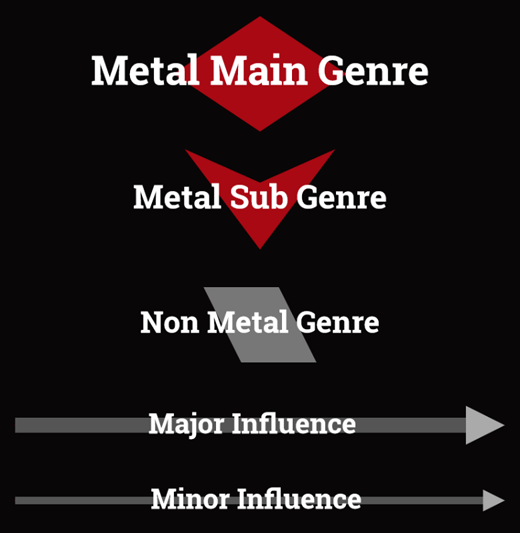The Interactive Metal Genres Graph
Experience the history and evolution of Metal and its numerous genres
Heavy Metal has been with us since 1968. Since then, Metal has experienced many transformations and stages of evolution. Metal has developed into many stylistic forms, fused with other musical genres, and influenced and shaped legions of musicians and people. But how and when did all the developments happen that led to the numerous and versatile Metal genres we know today? That´s the question we pursue here ...
The following timeline shows the musical, stylistic, and cultural origins of Metal and its manifold main genres and sub-genres.
A lot of efforts and investigations were put into analyzing the precise dates of the emergence of each known Metal genre including all Metal sub-genres. It also clarified the question which influences led to the development of each Metal genre and how each genre influenced the development of other genres.
Greatest value has been placed on historical accuracy to develop this map of Metal. The main source of information was the English, German, French, and Spanish version of Wikipedia, but also many articles on web pages and in magazines. The result of all these research studies is "The Interactive Metal Genres Graph".
The graph will never stop to develop. Nonetheless, it may always stay somehow inaccurate as some musical influences and developments cannot be appraised with perfect accuracy. Everything flows into one another.
The goal of this project is to have the most complete and most accurate visualization of the history of Metal that shows how Metal and its musical, stylistic and cultural surroundings got influenced and developed the Metal genres.
Legend

Hints
- The placement of a node on the timeline marks the emergence of the respective genre.
- To be declared as "Metal Main Genre", this genre has to be musically distinct AND (once) very popular in the Metal scene AND its cultural origins have to be older than 15 years.
- Please note that every "Non Metal Genre" does not have any incoming connections. In the graph, a "Non Metal Genre" can only serve as a parent node (and can never be a child node). Why? – Because it´s a Metal graph!
Usage
- Hold the left mouse button or pan to navigate in the graph.
- Use the mouse wheel or gestures to zoom in and out.
- Click or tap on any node to see direct parent (green) and child (blue) nodes.
Last update of the graph: March 2nd, 2024
If you are searching for a more graphical (but inaccurate) graph visit Map of Metal.
In case you just want to keep it simple.
Supplementary notes
- Until today, there are some disputes concerning the exact year in which Heavy Metal was born. Most people say that the first album of Black Sabbath, released in 1970 (recorded in 1969), marks the beginning. However, the first album of Led Zeppelin, released in 1969 (recorded in 1968), came up with some really heavy sounds. Some people even date the invention back to Blue Cheer's album "Vincebus Eruptum" (listen to the song "Doctor Please") released in 1968 (recorded in 1967). There are some more examples, but to make a long story short: Prior to the album "Black Sabbath", the sounds we nowadays see as building blocks for Heavy Metal were rather scattered. Black Sabbath were the first to deliver Heavy Metal in a pure form.
- The genre Heavy Metal once declared the Metal genre as a whole. Nowadays, the term is rather used to describe the classical and traditional playing style of Metal.
- In case anyone is missing the NWOBHM, the genres Heavy Metal and Speed Metal refer to this movement. Strictly speaking, the NWOBHM is not a genre. The same applies to the NWOAHM.
- The early examples of Power Metal lie in the late 1970s (some songs of Riot and Rainbow). However, the roots of Power Metal as a genre lie in the early 1980s when the European and U.S. style emerged.
- Since Viking Metal and Pagan Metal are defining themselves more textually than musically, they are only sub-genres. There are some disputes concerning the respective beginning. Folk Metal is seen as the main genre.
- Christian Metal defines itself through its texts. However, the music may belong to any genre. Although Christian Metal is very popular, these reasons declare it as a sub-genre.
- Dark Metal is very popular. This genre and its roots are very hard to define. There is no consensus. The genre is a collection of different musical and textual styles.
- Grindcore, Metalcore, and its sub-genres are musically at least as much Metal as Hardcore. That's why they are Metal genres.
- Alternative Metal is stylistically a very diverse genre and very hard to pinpoint. Although very popular, these circumstances prevent Alternative Metal from becoming a main genre.
- Stoner Metal is very similar to Stoner Rock. The terms are almost used interchangeably. Both genres were developed during the same time.
- Post-Black-Metal is extremely hard to define. There is no clear or distinct consensus about the term. Basically the term means nothing more or less than "Black Metal plus anything". That´s why its roots and influences are very hard to pinpoint and why you will not find this sub-genre in the graph.
Discussion & Comments
Give some feedback! Improvements and criticism are highly welcome. Please consider that any discussion must not be based on your personal opinion, but on objective verifiable facts. Every historical aspect has to be considered carefully.
